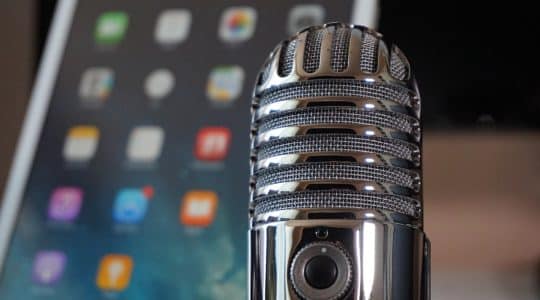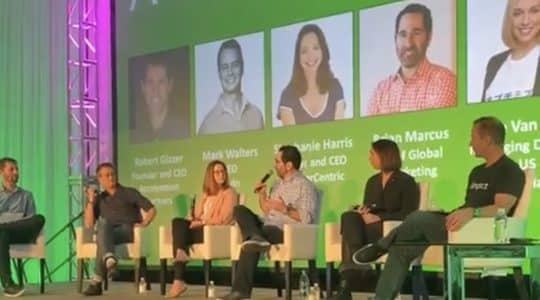This post was originally published by Geno Prussakov in the AM Navigator blog.
It’s time for me to bring you the newest conversation that has happened within the framework of my “Affiliate Marketing Legends” interview series. My today’s guest has an impressive amount of diverse affiliate marketing experience under his belt. He worked both for Google Affiliate Network (which, of course, is already history) and for eBay Partner Network, spoke at numerous conferences, and is now with TUNE. His career path and experience undoubtedly justify his inclusion in this interview series. Here is his profile (and the interview itself):
 Name: Brian Marcus
Name: Brian Marcus
Current Role: Vice President of Global Marketing
Company: TUNE
Place: Seattle, WA, USA
Find him at ![]()
![]()
![]()
![]()
GP: When and how did you get into affiliate marketing?
BM: My first exposure to Affiliate Marketing was in 2002, while leading the eCommerce and customer acquisition team for JC Whitney, a century-old automotive accessories cataloger that was making a transition to the web. My remit at JC Whitney was twofold: drive incremental new-to-file customers through all digital customer acquisition channels (including Search, Email, Display, Comparison Shopping, Data Feeds, and Affiliate) and own the business requirements for the new eCommerce platform.
At the time, affiliate marketing was the least understood of the marketing channels across the organization and among the executives. However, it was among the most attractive channels because it provided the company with a steady stream of new customers, at a predictable ROI. Taking over the internet marketing team afforded me the opportunity to dive into the affiliate channel deeply. It was a true education for me, as our program was launched on two separate networks, Performics and Commission Junction (later known as CJ Affiliate). It was there that I had my broadest exposure to the channel, understanding the nuances of the affiliate business, and the differences between the network technologies. Since Performics was based in Chicago (where I lived), I spent considerably more time interacting with the Performics team. A casual lunch meeting with the Performics CEO turned into a three-hour conversation about the channel and its promise. Through his wise counsel, I learned right there and then how I was not leveraging the channel in the most advantageous of ways. Our spirited conversation turned into a job interview.
 Shortly after that meeting, I officially joined Performics as Director of Publisher Development. Within a year, I was asked to lead the Advertiser Client Services team. Over an eight-year journey, I grew my team to 45 client service professionals and led the team through Google’s acquisition of DoubleClick, Performics’ parent company. As Google’s interest in affiliate began to decline, I decided to go deeper. I left Google to join eBay, where I would lead their Affiliate channel (called eBay Partner Network). And all of these experiences were the dress rehearsal for my current role at TUNE, where I am the VP of Global Marketing and work among the most experienced group of partner / affiliate marketing technologists in the world.
Shortly after that meeting, I officially joined Performics as Director of Publisher Development. Within a year, I was asked to lead the Advertiser Client Services team. Over an eight-year journey, I grew my team to 45 client service professionals and led the team through Google’s acquisition of DoubleClick, Performics’ parent company. As Google’s interest in affiliate began to decline, I decided to go deeper. I left Google to join eBay, where I would lead their Affiliate channel (called eBay Partner Network). And all of these experiences were the dress rehearsal for my current role at TUNE, where I am the VP of Global Marketing and work among the most experienced group of partner / affiliate marketing technologists in the world.
GP: If there was no affiliate marketing, what would you likely focus your efforts on?
BM: I tend to gravitate to three areas of interest: Marketing, Technology Platforms, and Network business models. Time and time again, I find myself in businesses built around technologies that empower users to extend and bolster their capabilities. Prior to affiliate marketing, as a consultant I spent almost a decade helping a wide variety of Fortune 500 companies leverage “enabling technologies” to dramatically improve business results. So, you can usually find me at the intersection of marketing and technology.
Throughout my career, I have also been perpetually attracted to businesses which are built around networks and marketplaces, such as eBay (merchandise marketplace), Teespring (digital printing marketplace), and Google (media marketplace). Lastly, I find myself increasingly interested in how Mobile plays into new marketing technologies.
Good news is that I really cannot imagine a universe where affiliate / partner marketing did not exist. Businesses need partnerships to extend their reach.
GP: You started at DoubleClick Performics to end up at Google Affiliate Network (GAN) after the former acquired the latter in 2008. A few years later, however, Google bailed out of affiliate marketing, shutting GAN down altogether. Back then, some immediately started assuming that if Google couldn’t make affiliate marketing work for them, there must definitely be something broken in it. What, in youropinion, were the real reasons for GAN’s “retirement”?

BM: Google is not your typical parent company. It is a place that shoots for the moon and often achieves it. When DoubleClick and Performics were acquired by Google, it was clear that stakes were high. Rarely did a business stay under the Google umbrella unless it was driving billions of dollars, and growing exponentially.
Consequently, I believe the reason GAN was shuttered came down to simple economics. Google could make significantly more money, and make it faster, by investing in its other core businesses instead of investing in GAN. Think of it this way: Google acquired DoubleClick, and got Performics as a bonus — a “free gift with purchase.” Google bought DoubleClick for its Ad Serving and Search platform; affiliate was (and is) a great business, but not the core reason DoubleClick was acquired. As competition intensified in the affiliate space and the business required more investment, incremental budget asks became harder to come by. Without increased investment, it became difficult to keep the leadership position. It came down to a simple financial thinking.
Well before GAN began assessing its viability, partner marketing platforms like TUNE (aka HasOffers) stepped into the scene to help networks and advertisers create direct marketing partnerships at scale. As these technologies improved and became more affordable, and as agencies focused their offerings, the total cost of running a private network (solely serving your brand) became affordable. So the competition shifted to software platforms that could focus on giving brands and networks more control and better technology, all at a lower cost.
Did GAN’s shutdown mean affiliate marketing was broken? In some ways, perhaps. I look at it as a clear signal to the marketplace that the traditional network model was in transition. I believe GAN’s shutdown opened a door for more focused and agile companies (like TUNE) to make affiliate marketing work better. Consequently, I believe that the shutdown of GAN was a tipping point for the new SaaS partner marketing platform category. Advertisers found themselves in a position where they had to make quick decisions and change providers after years of loyal partnership. In many ways, this move invigorated the space.

The above photo was taken by Brian earlier this morning. This gorgeous Seattle sunrise was too symbolic of the underpinning theme of this interview for us not to include it here.
GP: You’ve been in affiliate marketing for a very long time, and you have seen “a thing or two” happen. What issues, in your opinion, have never (really) been fully resolved and still represent “open questions”?
BM: Issue: Mobile is no longer a channel or a device, but foundational to all marketing, yet today’s tracking platforms do not make it a priority. This means that mobile partners are not getting proper compensation for app-to-app, cross-device and cross-channel efforts. This means that an entire sector of partners are simply undeserved in the partner portfolio. Question: Why hasn’t mobile affiliate been treated as a first-class citizen for brands?
Issue: Fraud continues to thrive, despite a proliferation of new ML and AI tools and data available to all actors. Question: What’s missing from today’s solutions to manage fraud more systematically and proactively?
Issue: Advertisers continue to use blunt instruments to deal with resource heavy, repetitive tasks in their daily workings across partner marketing. Spreadsheets rule the day and communication between advertisers and their partners has not progressed much in the past decade. Question: Where is the innovation to reduce dependency on paper based IOs, low-sophistication spreadsheets, and data silos? When will we see true automation and innovation help the affiliate space?
GP: A year after Google’s acquisition of DoubleClick, Lucas and Lee Brown started HasOffers (rebranded into HasOffers by TUNE later). They happen to be your current employer. As a senior executive at TUNE (which seems to be doing well) who was once at Google Affiliate Network (which is no longer around) what do you believe to be the secret sauce of the former (that the latter missed)?
BM: Lucas and Lee’s secret sauce is threefold: customer empathy, focus, and foresight into what it takes to build a great team. Fact is, Lucas and Lee were successful entrepreneurs before they graduated college. They experienced firsthand the potential of affiliate marketing, and they built a great platform before the rest of the world knew what to call it. As affiliates themselves, they recognized that the technologies available at the time to build performance-based partnerships lacked sophistication, cost too much, and fell short of their promise. So, they decided to develop a better solution. At the same time, they surrounded themselves with a team of experts who understood how to scale the platform and expand its user base. This is the origin story for the HasOffers product and how TUNE became the first mover in the world of SaaS Partner Marketing Platforms.
Conversely, GAN, like many of its contemporaries, did not have the DNA of an affiliate or a developer. Its heritage was client service; as such, its team operated similar to a strategic marketing agency. GAN knew how to run the best possible program, but often lacked the insights about the affiliate’s struggles “in the trenches.” Also, GAN was consumed with thriving in the world of Google. This distraction was a tax, especially when you consider that other players were wholly focused on affiliates and performance marketing.
Incidentally, I met the HasOffers by TUNE team almost six years ago, at your AM Days conference. At the time, I was running eBay’s Partner Network (ePN), one of the early private advertiser networks and I naively believed that only companies with the size and scale of eBay could make private networks work. It was at that conference that I started to see the promise of software-as-a-service as a solution for advertisers (and networks) in the performance world. Peter Hamilton (TUNE CEO) and Cameron Stewart (TUNE COO) were ahead of the curve and were already talking about it at that conference. And it was only after that conference that I started thinking about the implications of the ideas the TUNE team raised. I remember thinking to myself, “This is the future.”

GP: What are the top 3 hottest affiliate marketing topics/areas that we should keep an eye on in 2019?
BM: Not sure how to define “hot,” but top of mind for me include:
- Mobile as an enabler to building incremental marketing partnerships.
- Automation to improve human / business relationships.
- Brands leveraging partner marketing programs in unconventional ways.
GP: What is the “number one” thing that you wish every brand with an affiliate program did or did better?
BM: I wish advertisers truly understood the wide range of levers and dials at their disposal within their affiliate marketing programs — and their platforms. There is so much untapped potential in affiliate marketing, and it’s just left on the table due to lack of strategy or lack of tools, or both.
For example, there are a number of ways to dial up a program for growth beyond simply “pay more commission” to the same partners. How about unlocking net-new partnership types, such as mobile partnerships? Or inventing business development relationships that complement a brand or product? How about thinking of ways to tweak every aspect of the value chain within your partner program, such as thinking about discovering partners, onboarding partners, customer targeting, landing page selection, offer testing, user experience, partner communications, ad trafficking, merchandise curation, and policy/payment? Policy is actually one of the most overlooked levers of growth. Far too often policy is only thought of as a means to restrict, versus an opportunity to unlock. There are countless ways advertisers can grow once a trusting partner relationship is established.
There are also a number of ways to dial down unnecessary risks. Identifying patterns of fraud and sources of poor-quality traffic are a start. Operationalizing rules (in your platform) around these patterns is another. Correlating traffic quality to the traffic source is often viewed as too complex; it shouldn’t be. Marketers should have ready access to granular data that can be sliced and diced any which way.
Understanding these levers is the key to successful affiliate marketing, and I wish it were easier for brands to tap into these insights.
GP: What 3 ingredients of affiliate marketing success can no affiliate succeed without?
BM:
Trust
Advertisers are handing their brands over to publishers and networks. Advertisers need to find the right companies to partner with and then dive deep with them. Publishers and Networks are the experts and understand the best way to drive users. Relationships cannot succeed without trust.
Transparency
Optimization comes with clarity. Great tools and useful, timely data create insight to make good decisions. Publishers / Networks need it to work hardest for their Advertisers.
Accountability
Rules need to be honored. Efforts need to be rewarded. Tracking has to be accurate.
GP: What 3 things does every brand/advertiser need to do to succeed through affiliate programs/marketing?
BM:
- Educate the entire organization — yes, beyond marketing — about the ROI and the true value of the channel.
- Be more thoughtful about the goals and outcomes expected from their affiliate programs.
- Be clearer about their policies and their intentions. Be consistent in the way they apply their policies. And be a true partner to those that are trying to help them achieve their goals.
- Be more strategic about their partner portfolio. Choose carefully the partners that are best aligned to deliver on an advertiser’s goals.
GP: What would you do differently had you had a chance start everything all over again?
BM: Make my fortune as an affiliate before I graduated from college.
Author
Becky is the Senior Content Marketing Manager at TUNE. Before TUNE, she handled content strategy and marketing communications at several tech startups in the Bay Area. Becky received her bachelor's degree in English from Wake Forest University. After a decade in San Francisco and Seattle, she has returned home to Charleston, SC, where you can find her strolling through Hampton Park with her pup and enjoying the simple things between adventures with friends and family.




Leave a Reply
You must be logged in to post a comment.